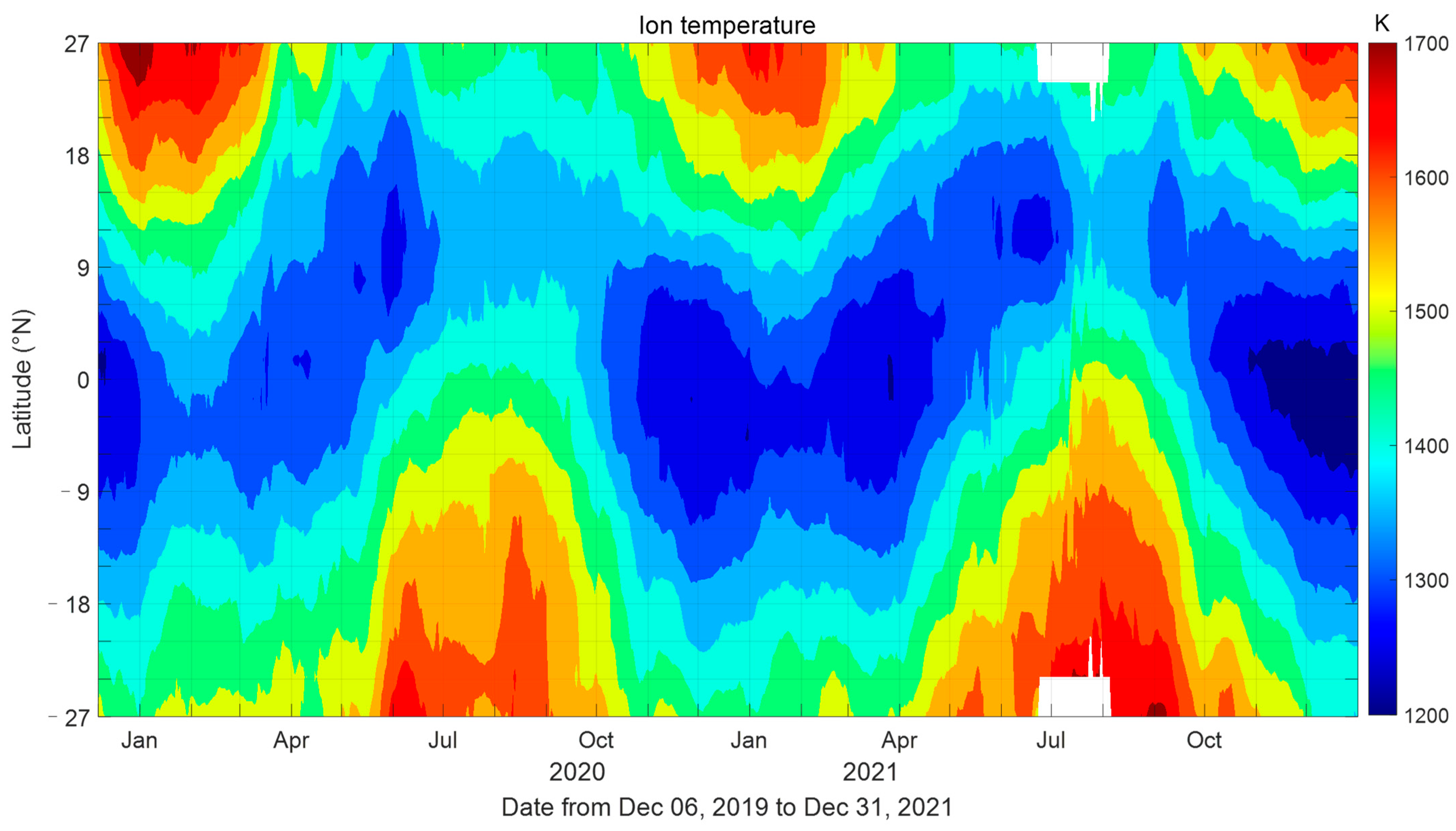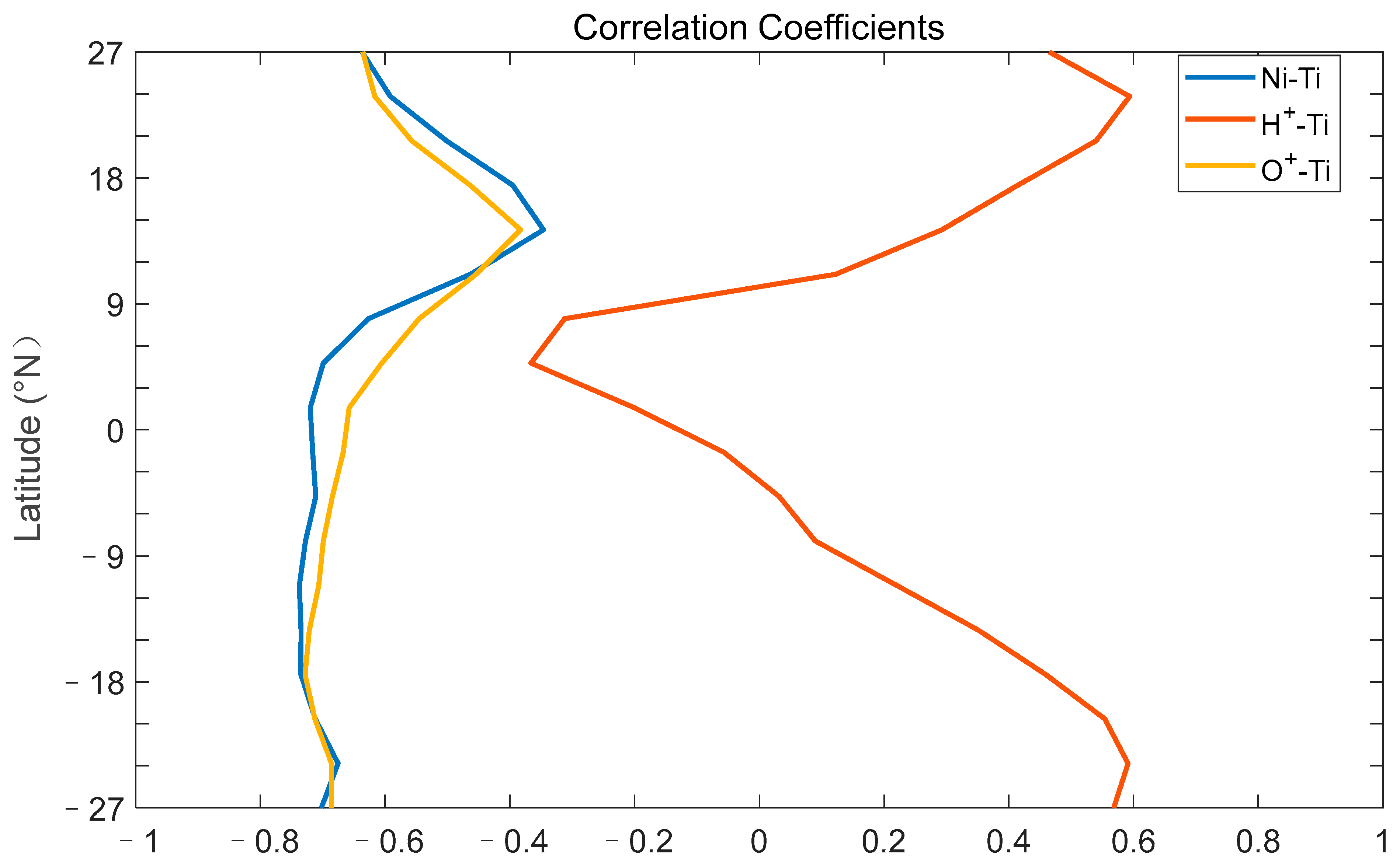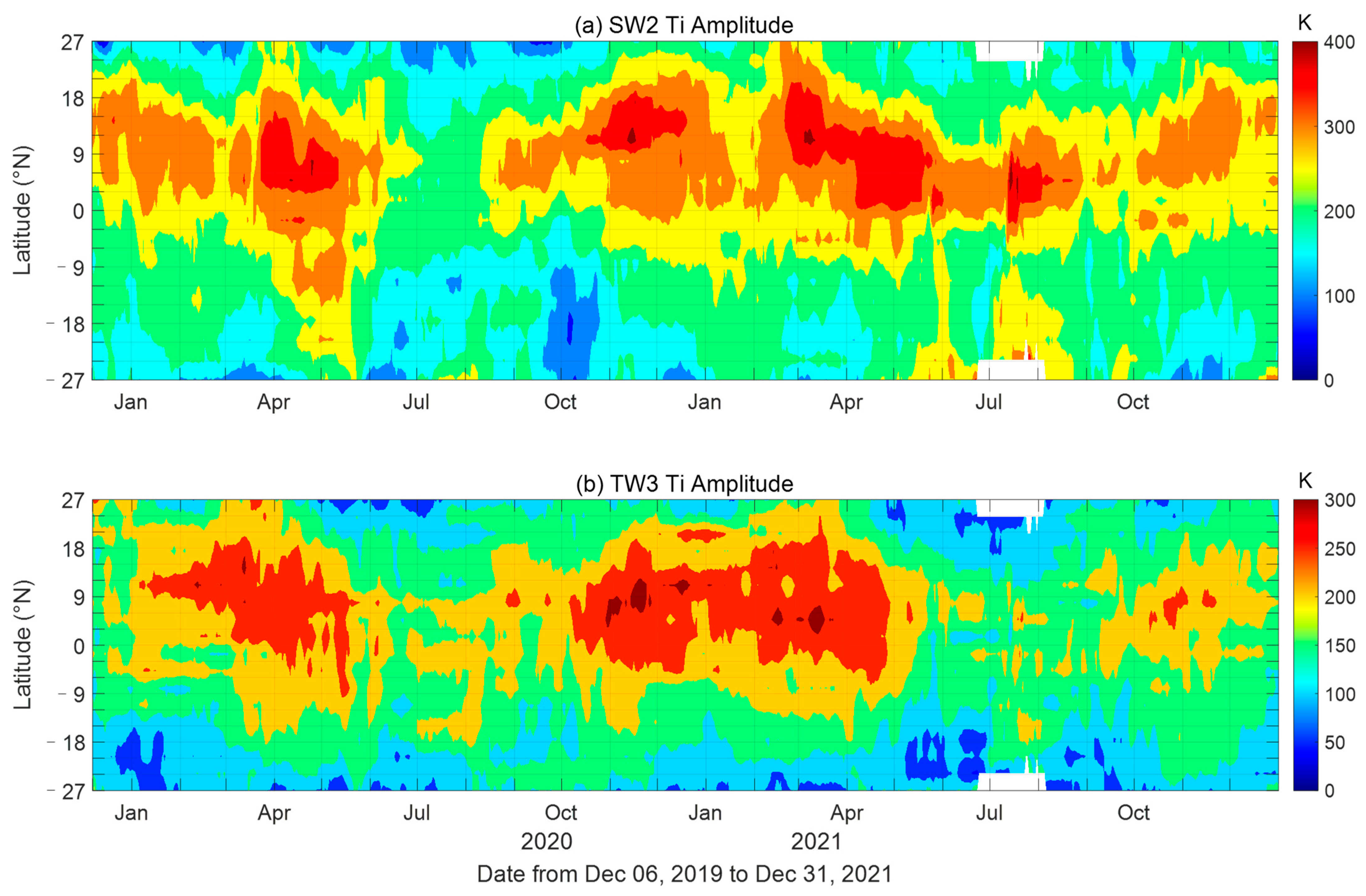Seasonal Variations in Ion Density, Ion Temperature, and Migrating Tides in the Topside Ionosphere Revealed by ICON/IVM
Abstract
1. Introduction
2. Data and Methodology
3. Observations and Discussions
3.1. Ion Density
3.2. Ion Temperature
3.3. Migrating Tides
4. Summary and Conclusions
- At 600 km, H+ density exhibits a semi-annual variation, and an annual variation is prominent in O+ density. The interannual variation in total ion density and O+ density is positively related to solar radiation from 2020 to 2021, while H+ density is not enhanced when solar radiation increases.
- Ion temperatures measured by the ICON/IVM reveal an enhancement in the winter hemisphere and a decrease in the summer hemisphere. However, an anticorrelation between ion temperature and total ion density is found in their seasonal variations at all observational latitudes. Similar negative correlations are also captured between ion temperature and O+ density. Interestingly, these negative correlations have the largest amplitude away from the magnetic equator, which indicates that thermal conduction mainly dominates the cooling mechanism for O+ outside the magnetic equatorial region.
- The seasonal variations in the semidiurnal and terdiurnal migrating tides in the topside ionosphere are generally consistent with the results derived from thermospheric temperature observations and ionospheric TEC measurements. However, the peak amplitudes of diurnal migrating tides in the topside ionosphere reveal different characteristics in the seasonal variations and latitudinal distributions, although semiannual oscillations are observed. The semiannual peaks are observed during winters and summers but are not during equinoxes. Additionally, the latitudinal peaks are separately located in the extra-equatorial regions but are not observed at the equator.
Author Contributions
Funding
Data Availability Statement
Acknowledgments
Conflicts of Interest
References
- Vickrey, J.F.; Swartz, W.E.; Farley, D.T. Ion transport in the topside ionosphere at Arecibo. J. Geophys. Res. Space Phys. 1979, 84, 7307–7314. [Google Scholar] [CrossRef]
- Erickson, P.J.; Swartz, W.E. Mid-latitude Incoherent Scatter Observations of Helium and Hydrogen Ions. Geophys. Res. Lett. 1994, 21, 2745–2748. [Google Scholar] [CrossRef]
- Sulzer, M.P.; González, S.A. Simultaneous measurements of O+ and H+ temperatures in the topside ionosphere over Arecibo. Geophys. Res. Lett. 1996, 23, 3235–3238. [Google Scholar] [CrossRef]
- Aponte, N.; Brum, C.G.M.; Sulzer, M.P.; González, S.A. Measurements of the O+ to H+ transition height and ion temperatures in the lower topside ionosphere over Arecibo for equinox conditions during the 2008–2009 extreme solar minimum. J. Geophys. Res. Space Phys. 2013, 118, 4465–4470. [Google Scholar] [CrossRef]
- Gong, Y.; Lv, X.; Zhou, Q.; Ma, Q.; Scott, M.; Zhang, S. Effect of temperature and vertical drift on helium ion concentration over Arecibo during solar maximum. J. Geophys. Res. Space Phys. 2019, 124, 9194–9202. [Google Scholar] [CrossRef]
- Gong, Y.; Lv, X.; Zhang, S.; Zhou, Q.; Ma, Z. The first observation of additional ionospheric layers over Arecibo using an incoherent scatter radar. Geophys. Res. Lett. 2022, 49, e2021GL097019. [Google Scholar] [CrossRef]
- González, S.A.; Fejer, B.G.; Heellis, R.A.; Hanson, W.B. Ion composition of the topside equatorial ionosphere during solar minimum. J. Geophys. Res. Space Phys. 1992, 97, 4299–4303. [Google Scholar] [CrossRef]
- Fejer, B.G.; Jensen, J.W.; Su, S.-Y. Quiet time equatorial F region vertical plasma drift model derived from ROCSAT-1 observations. J. Geophys. Res. Space Phys. 2008, 113, A05304. [Google Scholar] [CrossRef]
- Xiong, C.; Lühr, H.; Stolle, C. Seasonal and latitudinal variations of the electron density nonmigrating tidal spectrum in the topside ionospheric F region as resolved from CHAMP observations. J. Geophys. Res. Space Phys. 2014, 119, 10416–10425. [Google Scholar] [CrossRef]
- Shen, X.H.; Zhang, X.M.; Yuan, S.G.; Wang, L.W.; Cao, J.B.; Huang, J.P. The state-of-the-art of the China Seismo-Electromagnetic Satellite mission. Sci. China Technol. Sci. 2018, 61, 634–642. [Google Scholar] [CrossRef]
- Pezzopane, M.; Pignalberi, A. The ESA Swarm mission to help ionospheric modeling: A new NeQuick topside formulation for midlatitude regions. Sci. Rep. 2019, 9, 12253. [Google Scholar] [CrossRef] [PubMed]
- Li, J.; Chen, Y.; Liu, L.; Le, H.; Zhang, R.; Huang, H.; Li, W. Occurrence of Ionospheric Equatorial Ionization Anomaly at 840 km height observed by the DMSP satellites at solar maximum dusk. Space Weather 2021, 19, e2020SW002690. [Google Scholar] [CrossRef]
- Craven, P.D.; Comfort, R.H.; Richards, P.G.; Grebowsky, J.M. Comparisons of modeled N+, O+, H+, and He+ in the midlatitude ionosphere with mean densities and temperatures from Atmosphere Explorer. J. Geophys. Res. Space Phys. 1995, 100, 257–268. [Google Scholar] [CrossRef]
- West, K.H.; Heelis, R.A. Longitude variations in ion composition in the morning and evening topside equatorial ionosphere near solar minimum. J. Geophys. Res. Space Phys. 1996, 101, 7951–7960. [Google Scholar] [CrossRef]
- Su, Y.Z.; Oyama, K.-I.; Bailey, G.J.; Fukao, S.; Takahashi, T.; Oya, H. Longitudinal variations of the topside ionosphere at low latitudes: Satellite measurements and mathematical modelings. J. Geophys. Res. Space Phys. 1996, 101, 17191–17205. [Google Scholar] [CrossRef]
- Bilitza, D.; Altadill, D.; Truhlik, V.; Shubin, V.; Galkin, I.; Reinisch, B.; Huang, X. International Reference Ionosphere 2016: From ionospheric climate to real-time weather predictions. Space Weather 2017, 15, 418–429. [Google Scholar] [CrossRef]
- Su, S.Y.; Yeh, H.C.; Heelis, R.A.; Wu, J.; Yang, S.C.; Lee, L.; Chen, H.L. The ROCSAT-1 IPEI preliminary results: Low-latitude ionospheric plasma and flow variations. Terr. Atmos. Ocean. Sci. 1999, 10, 787–804. [Google Scholar] [CrossRef]
- de La Beaujardiere, O.; The C/NOFS Science Definition Team. C/NOFS: A mission to forecast scintillations. J. Atmos. Sol.-Terr. Phys. 2004, 66, 1573–1591. [Google Scholar] [CrossRef]
- Huba, J.D.; Heelis, R.; Maute, A. Large-scale O+ depletions observed by ICON in the post-midnight topside ionosphere: Data/model comparison. Geophys. Res. Lett. 2021, 48, e2020GL092061. [Google Scholar] [CrossRef]
- Immel, T.J.; England, S.; Mende, S.; Heelis, R.; Englert, C.; Edelstein, J. The Ionospheric Connection Explorer mission: Mission goals and design. Space Sci. Rev. 2018, 214, 13. [Google Scholar] [CrossRef]
- González, S.A.; Sulzer, M.P.; Nicolls, M.J.; Kerr, R.B. Solar cycle variability of nighttime topside helium ion concentrations over Arecibo. J. Geophys. Res. Space Phys. 2004, 109, A07302. [Google Scholar] [CrossRef]
- Ram, S.T.; Liu, C.H.; Su, S.-Y.; Heelis, R.A. A comparison of ionospheric O+/light-ion transition height derived from ion-composition measurements and the topside ion density profiles over equatorial latitudes. Geophys. Res. Lett. 2010, 37, L20107. [Google Scholar] [CrossRef]
- Truhlík, V.; Bilitza, D.; Trísková, L. Towards better description of solar activity variation in the International Reference Ionosphere topside ion composition model. Adv. Space Res. 2015, 55, 2099–2105. [Google Scholar] [CrossRef]
- Truhlík, V.; Trísková, L.; Šmilauer, J. Manifestation of solar activity in the global topside ion composition—A study based on satellite data. Ann. Geophys. 2005, 23, 2511–2517. [Google Scholar] [CrossRef]
- West, K.H.; Heelis, R.A.; Rich, F.J. Solar activity variations in the composition of the low-latitude topside ionosphere. J. Geophys. Res. Space Phys. 1997, 102, 295–305. [Google Scholar] [CrossRef]
- Sharma, D.K.; Rai, J.; Israil, M.; Subrahmanyam, P. Diurnal, seasonal and latitudinal variations of ionospheric temperatures of the topside F region over the Indian region during solar minimum (1995–1996). J. Atmos. Sol. Terr. Phys. 2005, 67, 267–274. [Google Scholar] [CrossRef]
- Chen, Y.; Liu, L.; Wan, W.; Yue, X.; Su, S.-Y. Solar activity dependence of the topside ionosphere at low latitudes. J. Geophys. Res. Space Phys. 2009, 114, A08306. [Google Scholar] [CrossRef]
- Borgohain, A.; Bhuyan, P.K. Solar cycle variation of ion densities measured by SROSS C2 and FORMOSAT-1 over Indian low and equatorial latitudes. J. Geophys. Res. Space Phys. 2010, 115, A04309. [Google Scholar] [CrossRef]
- Shen, X.; Zhang, X. The spatial distribution of hydrogen ions at topside ionosphere in local daytime. Terr. Atmos. Ocean. Sci. 2017, 28, 1009–1017. [Google Scholar] [CrossRef]
- Förster, M.; Jakowski, N. Geomagnetic Storm Effects on the Topside Ionosphere and Plasmasphere: A Compact Tutorial and New Results. Surv. Geophys. 2020, 21, 47–87. [Google Scholar] [CrossRef]
- Rich, F.J.; Sultan, P.J.; Burke, W.J. The 27-day variations of plasma densities and temperatures in the topside ionosphere. J. Geophys. Res. Space Phys. 2003, 108, 1297. [Google Scholar] [CrossRef]
- Gong, Y.; Zhou, Q.; Zhang, S. Atmospheric tides in the low-latitude E and F regions and their responses to a sudden stratospheric warming event in January 2010. J. Geophys. Res. Space Phys. 2013, 118, 7913–7927. [Google Scholar] [CrossRef]
- Gong, Y.; Zhou, Q.; Zhang, S.D.; Aponte, N.; Sulzer, M.; Gonzalez, S. The F region and topside ionosphere response to a strong geomagnetic storm at Arecibo. J. Geophys. Res. Space Phys. 2013, 118, 5177–5183. [Google Scholar] [CrossRef]
- Kakinami, Y.; Watanabe, S.; Yamamoto, M.-Y.; Chao, C.-K. Correlations between ion density and temperature in the topside ionosphere measured by ROCSAT-1. J. Geophys. Res. Space Phys. 2014, 119, 9207–9215. [Google Scholar] [CrossRef]
- Gong, Y.; Zhou, Q. Incoherent scatter radar study of the terdiurnal tide in the E- and F-region heights at Arecibo. Geophys. Res. Lett. 2011, 38, L15101. [Google Scholar] [CrossRef]
- Gong, Y.; Ma, Z.; Lv, X.; Zhang, S.; Zhou, Q.; Aponte, N.; Sulzer, M. A study on the quarterdiurnal tide in the thermosphere at Arecibo during the February 2016 sudden stratospheric warming event. Geophys. Res. Lett. 2018, 45, 13142–13149. [Google Scholar] [CrossRef]
- Gong, Y.; Lv, X.; Zhang, S.; Zhou, Q.; Ma, Z. Climatology and seasonal variation of the thermospheric tides and their response to solar activities over Arecibo. J. Atmos. Sol. Terr. Phys. 2021, 215, 105592. [Google Scholar] [CrossRef]
- Chen, G.; Li, Y.X.; Ning, B.Q.; Gong, W.L.; Yoshikawa, A.; Hozumi, K. Multi-Instrument Observations of the Atmospheric and Ionospheric Response to the 2013 Sudden Stratospheric Warming Over Eastern Asia Region. IEEE Trans. Geosci. Remote Sens. 2020, 58, 1232–1243. [Google Scholar] [CrossRef]
- Hagan, M.E.; Roble, R.G.; Hackney, J. Migrating thermospheric tides. J. Geophys. Res. Space Phys. 2001, 106, 12739–12752. [Google Scholar] [CrossRef]
- Xu, J.; Smith, A.K.; Liu, H.-L.; Yuan, W.; Wu, Q.; Jiang, G.; Mlynczak, M.G.; Russell, J.M.; Franke, S.J. Seasonal and quasi-biennial variations in the migrating diurnal tide observed by Thermosphere, Ionosphere, Mesosphere, Energetics and Dynamics (TIMED). J. Geophys. Res. Atmos. 2009, 114, D13107. [Google Scholar] [CrossRef]
- Luan, X.; Dou, X.; Lei, J.; Jiang, G. Terdiurnal migrating-tide signature in ionospheric total electron content. J. Geophys. Res. Space Phys. 2012, 117, A11302. [Google Scholar] [CrossRef]
- Liu, H.-L.; Richmond, A.D. Attribution of ionospheric vertical plasma drift perturbations to large-scale waves and the dependence on solar activity. J. Geophys. Res. Space Phys. 2013, 118, 2452–2465. [Google Scholar] [CrossRef]
- Chang, L.C.; Lin, C.-H.; Liu, J.-Y.; Balan, N.; Yue, J.; Lin, J.-T. Seasonal and local time variation of ionospheric migrating tides in 2007–2011 FORMOSAT-3/COSMIC and TIE-GCM total electron content. J. Geophys. Res. Space Phys. 2013, 118, 2545–2564. [Google Scholar] [CrossRef]
- Immel, T.J.; Harding, B.J.; Heelis, R.A. Regulation of ionospheric plasma velocities by thermospheric winds. Nat. Geosci. 2021, 14, 893–898. [Google Scholar] [CrossRef] [PubMed]
- He, M.; Chau, J.L.; Forbes, J.M.; Zhang, X.; Englert, C.R.; Harding, B.J. Quasi-2-day wave in low-latitude atmospheric winds as viewed from the ground and space during January–March, 2020. Geophys. Res. Lett. 2021, 48, e2021GL093466. [Google Scholar] [CrossRef]
- Dhadly, M.S.; Englert, C.R.; Drob, D.P.; Emmert, J.T.; Niciejewski, R.; Zawdie, K.A. Comparison of ICON/MIGHTI and TIMED/TIDI neutral wind measurements in the lower thermosphere. J. Geophys. Res. Space Phys. 2021, 126, e2021JA029904. [Google Scholar] [CrossRef] [PubMed]
- Hanson, W.B.; Sanatani, S.; Zuccaro, D.; Flowerday, T.W. Plasma measurements with the retarding potential analyzer on Ogo 6. J. Geophys. Res. 1970, 75, 5483–5501. [Google Scholar] [CrossRef]
- Heelis, R.A.; Stoneback, R.A.; Perdue, M.D.; Depew, M.D.; Morgan, W.A.; Mankey, M.W. Ion velocity measurements for the ionospheric connections explorer. Space Sci. Rev. 2017, 212, 615–629. [Google Scholar] [CrossRef]
- Xu, J.; Smith, A.K.; Yuan, W.; Liu, H.-L.; Wu, Q.; Mlynczak, M.G.; Russell III, J.M. Global structure and long-term variations of zonal mean temperature observed by TIMED/SABER. J. Geophys. Res. Atmos. 2007, 112, D24106. [Google Scholar] [CrossRef]
- Zhou, Q.H.; Sulzer, M.P. Incoherent scatter radar observations of the F-region ionosphere at Arecibo during January 1993. J. Atmos. Sol. Terr. Phys. 1997, 59, 2213–2229. [Google Scholar] [CrossRef]
- Zhang, X.; Shen, X.; Yuan, G. The solar cycle variations of plasma parameters and their correlations at topside ionosphere from DEMETER during 2005–2010. Adv. Space Res. 2015, 56, 1374–1388. [Google Scholar] [CrossRef]
- Borgohain, A.; Bhuyan, P.K. Effect of solar cycle on topside ion temperature measured by SROSS C2 and ROCSAT 1 over the Indian equatorial and low latitudes. Ann. Geophys. 2012, 30, 1645–1654. [Google Scholar] [CrossRef][Green Version]
- Hsu, C.-T.; Heelis, R.A. Modeling the daytime energy balance of the topside ionosphere at middle latitudes. J. Geophys. Res. Space Phys. 2017, 122, 5733–5742. [Google Scholar] [CrossRef]
- Sridharan, S. Seasonal variations of low-latitude migrating and nonmigrating diurnal and semidiurnal tides in TIMED-SABER temperature and their relationship with source variations. J. Geophys. Res. Space Phys. 2019, 124, 3558–3572. [Google Scholar] [CrossRef]
- Andrioli, V.F.; Xu, J.; Batista, P.P.; Resende, L.C.A.; Da Silva, L.A.; Marchezi, J.P. New findings relating tidal variability and solar activity in the low latitude MLT region. J. Geophys. Res. Space Phys. 2022, 127, e2021JA030239. [Google Scholar] [CrossRef]







Disclaimer/Publisher’s Note: The statements, opinions and data contained in all publications are solely those of the individual author(s) and contributor(s) and not of MDPI and/or the editor(s). MDPI and/or the editor(s) disclaim responsibility for any injury to people or property resulting from any ideas, methods, instructions or products referred to in the content. |
© 2023 by the authors. Licensee MDPI, Basel, Switzerland. This article is an open access article distributed under the terms and conditions of the Creative Commons Attribution (CC BY) license (https://creativecommons.org/licenses/by/4.0/).
Share and Cite
Ma, Z.; Gong, Y.; Zhang, S.; Bao, J.; Yin, S.; Zhou, Q. Seasonal Variations in Ion Density, Ion Temperature, and Migrating Tides in the Topside Ionosphere Revealed by ICON/IVM. Remote Sens. 2023, 15, 5205. https://doi.org/10.3390/rs15215205
Ma Z, Gong Y, Zhang S, Bao J, Yin S, Zhou Q. Seasonal Variations in Ion Density, Ion Temperature, and Migrating Tides in the Topside Ionosphere Revealed by ICON/IVM. Remote Sensing. 2023; 15(21):5205. https://doi.org/10.3390/rs15215205
Chicago/Turabian StyleMa, Zheng, Yun Gong, Shaodong Zhang, Jiaxin Bao, Song Yin, and Qihou Zhou. 2023. "Seasonal Variations in Ion Density, Ion Temperature, and Migrating Tides in the Topside Ionosphere Revealed by ICON/IVM" Remote Sensing 15, no. 21: 5205. https://doi.org/10.3390/rs15215205
APA StyleMa, Z., Gong, Y., Zhang, S., Bao, J., Yin, S., & Zhou, Q. (2023). Seasonal Variations in Ion Density, Ion Temperature, and Migrating Tides in the Topside Ionosphere Revealed by ICON/IVM. Remote Sensing, 15(21), 5205. https://doi.org/10.3390/rs15215205






